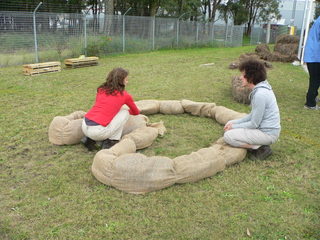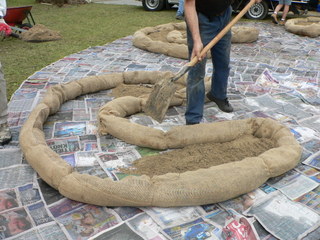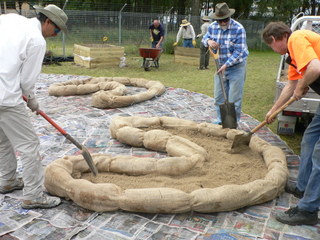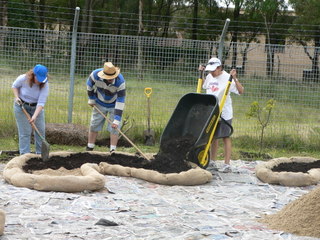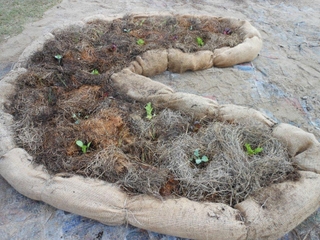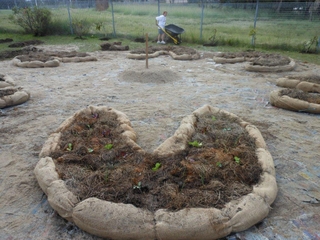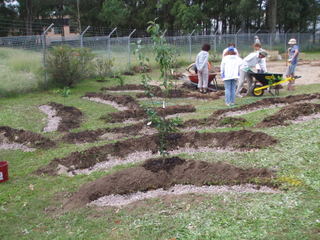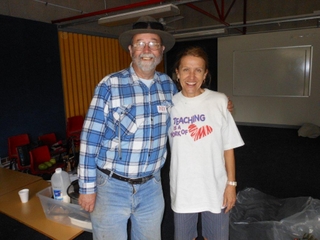
Before we could hold the big day, I had to have one more meeting with the vice Principle (Gwen) who was driving the project to identify exactly what we expected to achieve on the day and the resources we would need to accomplish those expectations. We decided to split the people there on the day into three teams, assuming we had enough, one for the fruit trees and fish scale swales, one for the mandala garden and one for the wicking beds and if time permitted the flower towers. The herb spiral and chook tractor would have to wait for another time.
Gwen and I had both developed various contacts over the years and we both used them to get as much of the materials that we would need for the day on the cheap or as freebies, and the list we came up with was –
- Newspapers - for sheet mulching
- Mushroom compost -for mulching and to make growing medium
- Coarse sand -for the swales and to mix with the mushroom compost to make growing medium
- Gravel – for the swales and the wicking beds
- Plastic sheeting- for the wicking beds
- Rolls of hessian – for the mandala garden
- Seedlings – for the mandala garden and the wicking beds
- Straw – for the mandala garden and as mulch on the wicking beds
- A comprehensive selection of hoes, shovels, spades, wheelbarrows and other implements of destruction
- Other assorted bits and pieces,
- As many teachers, parents, kids and concerned citizens (from our local Permaculture group) as we could find
- Lunch!
What is a Permablitz?
Our Permaculture group (Permaculture Sydney West Inc.) gets together on the fourth Sunday of the month at one of our members place or some other agreed venue to help develop their garden/yard area along Permaculture lines. Anyone can come so long as they are a member and they are covered by our public liability insurance. We all have fun, get to practice Permaculture skills and/or learn new skills and help someone improve their food producing capacity. I was able to get the school Permaculture garden development declared a permablitz which meant we had lots of not only willing but also highly skilled hands to put the project together.
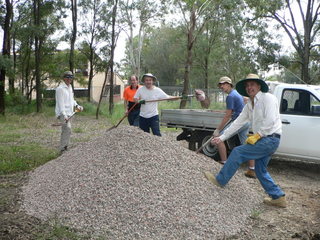
I was also able to get two of our very experienced ladies to agree to look after an aspect of the project each (one did the swales while the other looked after the mandala garden) while I concentrated on the wicking bed and kept a weather eye on the other two parts. This meant that I had an experienced overseer on each facet of the project to minimise the chance of stuff up. (stuff-up proof doesn’t exist!)
On The Day
Gwen, the principal and I were there somewhat early to make sure that all was well and to look at the area as well as checking the supplies. Everything seemed to be in order and people were starting to arrive. They had organised some signs to show where we were working because it was at the back of the school and not visible from the road. We had almost 20 teachers and permies turn up and a few other concerned citizens from our gardening group but sadly no parents.
Before starting we had a quick talk about the various activities to take place, where they were going to take place, any safety issues involved and the location of toilets, supplies etc. One of the group bad brought his ute so we were able to use that to haul loads of sand, gravel and mushroom compost from the stock piles to where they were needed. We had received quite a bit of rain so he did get the ute bogged a couple of times, but thankfully there was a four wheel drive vehicle available to pull him out.
The activities
The Fruit Frees and Fish-Scale Swales
There is an article in the fruit area of this site already covering the work we did around this activity and rather than reproduce it all again I suggest you wander over to that part of the site if fruit trees and fish-scale swales interests you.
The Mandala Garden
This is the second major work to be carried out on the day and we started it once the swale making was under way. To start, we looked at the area and worked out where the probable centre of the mandala would be, at which point I drove in a stake and tied some string to it, then ran out the string to where we figured the edge of the circle would be. It turned out we were a bit far south and so I moved the stake to the north a metre or so then drove it in. By holding the spray marker at the end of the string and walking around the stake I was able to draw a circle around what would become the mandala garden and after looking at it from several different angles we came to the conclusion is was the right size and in the right space.
The first job in making the mandala garden was to sheet mulch the area with wet newspapers. Gwen had been able to pull some strings and got a whole lot of unused local newspapers which were perfect for sheet mulching, but we needed to have them wet so they wouldn’t blow away and would tend to stick together. I placed a load in the wheelbarrow and filled it full of water to allow them to soak.
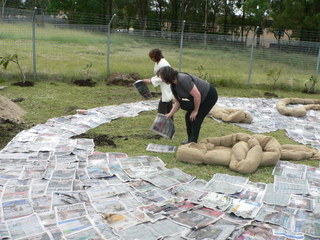
By this time the fish scale swales were moving on well and we had some very willing workers to cover the area of the mandala garden with wet newspapers. The full thickness of the newspaper were laid first around the outer circumference of the circle, overlapping so that there was no open areas for the grass underneath to poke through. The circle was then filled in paper by paper until we had a huge circle of wet newspaper, which is a lot more exciting to see than it sounds......anyway, it was then time to make the garden bed edging.
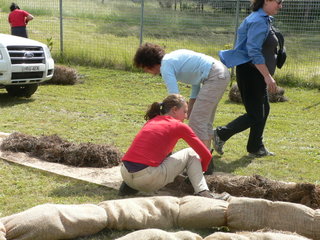
I saw an idea in an American book on developing school gardens for the edging of garden beds using hessian and straw, the idea being that you lay the hessian out flat, place lengths of straw on it then fold it around so it looks like a sausage and wrap string around to hold it together. It is soft for the kid and biodegradable so it will eventually rot down, and that is what we did. We got some 10 metre rolls of hessian from Bunnings and our friend at Mamre Produce donated some straw and we had enough to make 6 keyhole beds which made up part of the mandala. This was a little different to my original design of 8 keyhole beds but we took 2 out so we could allow for disabled students to get access to the keyhole beds too.
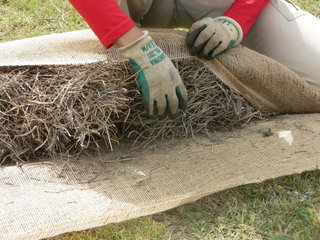
Some of the ladies got together to make the keyhole bed surrounds and once they were complete we arranged them roughly equidistant around the mandala, formed them into the keyhole shape and filled them with the mushroom compost and sand growing medium. The keyhole shape allows access to all parts of the bed without needing to walk on the growing area. One bed was planted up with the seedlings and mulched and the rest were left to be planted out by the students.
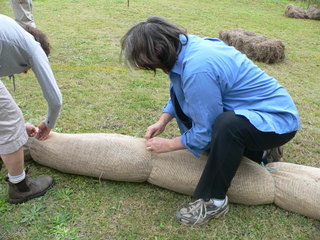
The guys had done a good job of relocating lots of sand from the stockpile with the ute, so some of the leftover sand was piled up in the centre of the mandala to set things up for the herb spiral to be completed at a later date. The rest of the leftover sand was spread evenly over the surface of the newspaper to keep it from blowing away.
The Wicking Beds
The construction process for wicking beds is also covered elsewhere on the site (under veggies/container gardening/our wicking bed) but we had to make a couple of design changes on the day from our usual design. It is still based on the 2 x 1200mm x 1200mm AQC treated raised beds, one on top of the other but because the only roll of plastic they could get hold of to make the bottom reservoir was only 1000mm wide, we had to make do with some thinner plastic that had been used to wrap a mattress in that Gwen had bought in to use. We also had no wood chips so to go in the water reservoir are we had to use gravel, which worked OK.
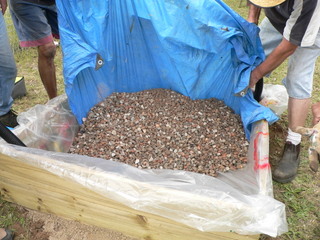
We only had enough plastic to make one wicking bed so everyone got stuck into that one, the rest having to wait until another time. With the plastic being so thin we dug out the grass from under the bed and then lined it with some of the sand so that there wouldn’t be any grass trying to push its way up and making a hole in the plastic. We also poured in the gravel veeerrry carefully so that we wouldn’t tear the plastic but in the end it worked well. We made more growing medium from a mix of sand and mushroom compost, used some of the straw to mulch the bed, filled the reservoir with water and then plated veggie seedlings into it.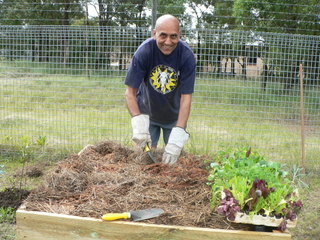
What didn’t get Done
Due to lack of people, lack of raw materials or both we were unable to –
- Complete the wicking beds
- Put the straw bale teaching area in
- Make and install the flower towers
We also didn’t get in the herb spiral or the chook tractor but we realised that this was unlikely to happen anyway, even with a bigger crew.
Wrap up of the Day
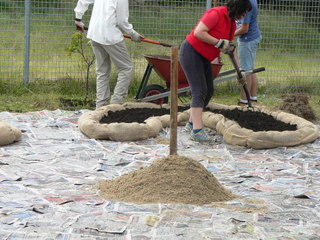
As with all blitzes, the host (in this case Gwen, the principal and a couple of teachers) made a stack of food for everyone and we had a wonderful lunch. Everyone was working so well and getting stuff done it took quite a while to get everyone to stop working and come in for lunch. It was a great day, but there is still more to do so we will be getting everyone together again to finish things off, when the weather gets better!
Forming the Keyhole Beds in the Mandala Garden